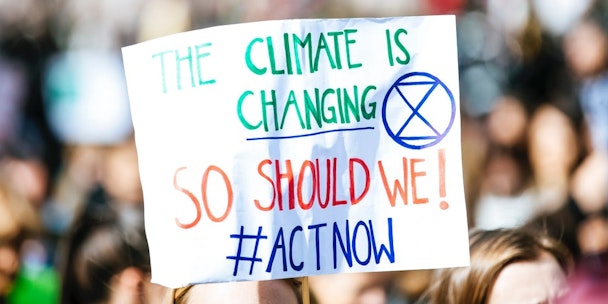Cop26 showed us that social purpose can’t be led by the marketing department
Joe Wade, founder at London ad agency Don’t Panic, reflects on Cop26 and why it highlighted that social purpose can’t be led by marketing departments.

Joe Wade reflects on Cop26
Projections by the University of Melbourne have shown that although Cop26 didn’t go far enough to limit the world to the targeted 1.5C temperature rise, we may now be on track to an increase below 2C for the first time. So, along with being grateful for a milder apocalypse, we know we need to do more.
I was in the Green Zone at Cop26 and it was absolutely heaving with companies trying to make the case that they were already all over climate change. The implication was: “Please politicians, don’t regulate us to save the planet, it sounds costly and we’re already invested in this flashy but futile eco scheme.”
A bit like that billionaire couple who recently bought a vegan helicopter, they’ve missed the point.
Social purpose, particularly around the most pressing issue of our time, can’t be led by the marketing department and it should hit your bottom line – not only because it’s the right and only thing to do for young people, future generations and people already suffering the impact of climate change in the Global South. It has to be approached in an authentic way because if it’s not everyone will know you’re full of shit. It’s like Shell sponsoring the climate change exhibition at the Science Museum while simultaneously appealing against the Dutch court ruling that it needs to cut its emissions.
Our new Get Fit for Purpose report is structured around the ESGs, and so along with an environment section it outlines how to tackle social and governance issues.
You might be thinking, who the fuck are you to tell us about the ESGs? Well, apart from having been doing social purpose since before it was a thing, the report is actually brought to you by over 20 charities, NGOs and advocacy groups. Why? Because who knows better how to tackle issues and causes than not-for-profits, especially Extinction Rebellion, WaterAid, Amnesty International, WWF, Greenpeace, Crisis, Stop Hate UK and Age International? These key individuals have helped us build a framework for businesses to pave the way for incremental change and accommodate a ‘small wins’ approach that can get bigger companies closer to being truly value-led.
The report kicks off with a foreword by Richard Curtis, who’s been encouraging businesses to do better since Ceefax with Comic Relief, Sport Relief and more recently Make My Money Matter. He’s also the person who put the Global Goals on the map, which we’ve also used to shape the report’s recommendations.
The Get Fit for Purpose report is available to download from the Don’t Panic website here.
Here’s a taster of our dos and don’ts of Social Purpose:
-
Social purpose can’t be led by the marketing department. Marketing can only kick in after work has driven real change, then it can be shouted about. Otherwise it’s bullshit, like Gillette or Pepsi, or some kind of initiative the fossil fuel companies cook up involving offsetting. One of our clients has been working for five years on a gender-based initiative and is only ready to talk about it publically now.
-
When ready, use lead-in or trial initiatives before going full-throttle and rehauling your existing brand.
-
Make small changes that ladder up to a genuine shift in behavior rather than making one big move, which can make audiences skeptical.
-
Invest in campaign efforts that make a difference in their own right. Even if you’ve not got it all figured out just yet, if the execution itself creates real positive change, that’s a step in the right direction.
-
If purpose isn’t inherent to your product or service, partner with a non-profit with the relevant experience. This ensures you are supporting existing initiatives (bottom-up) and provides a platform for the nonprofit.
-
Know your place and don’t overclaim. Small steps are great, but they can’t single-handedly change the world.
-
Transparency is key. It’s OK to admit you’re not perfect, but couple this with the tangible actions you are taking toward change. This is disarming for critics and leaves you with a roadmap for internal and external orientation.
-
Don’t forget to look at your internal processes as well as external ones. Bring stakeholders and employees along for the ride. This will give your team something to be proud of and helps with recruitment.
-
Spend money. Social purpose will generate ROI but is likely to require investment in the short term. If it’s not costing you much, you might not be going far enough.
-
Don’t be too worthy with your advertising – it’s easy to get sucked into classic purpose tropes using language like ‘togetherness,’ but it’s better to entertain and be memorable.
-
Become a catalyst for change not only in your business, but throughout your industry and sector. Be an ally by prompting businesses to behave responsibly.
-
Don’t turn back. Commit to longer-term change rather than a one-off sustainability campaign. Real change is made through long-term commitment.
